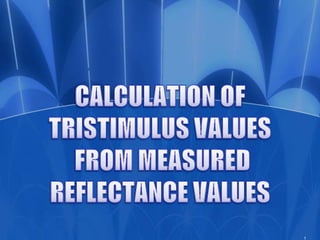
3.7 calculation of tristimulus values from measured reflectance values
- 1. 1
- 2. Measured Reflectance Rλ Suppose that we have a sample, such as a painted surface, and that we have measured the fraction of light reflected at each wavelength, Rλ. Provided that the sample is not fluorescent, the Rλ values will be completely independent of the light shone on the sample. (Many instruments give readings in terms of the percentage of light reflected, i.e. Rλ ´ 100, but fractions are easier to use in the present discussion.) . 2
- 3. Measured Reflectance Rλ For example, a white paint will reflect about 90% of the incident light (i.e. Rλ= 0.9) at, say, 500 nm Whether illuminated with strong daylight or with weak tungsten light. Thus the Rλvalues are independent of the actual light source used in the spectrophotometer. . 3
- 4. Measured Reflectance Rλ The actual amount of light reflected will be different for different light sources, however. Suppose that the sample is now viewed under a light source for which the light emitted at each wavelength is Eλ. Then the amount reflected at each wavelength will be Eλ x Rλ. Now if we consider only light of wavelength l, one unit of energy of l can be matched by an additive mixture of x– l units of [X] together with y– l units of [Y] and z– l units of [Z] (Eqn 3.8): . 4
- 5. Measured Reflectance Rλ Then the amount reflected at each wavelength will be Eλ x Rλ. Now if we consider only light of wavelength λ, one unit of energy of λ can be matched by an additive mixture of xλ units of [X] together with yλ units of [Y] and z–λ units of [Z] (Eqn 3.8): 5
- 6. Measured Reflectance Rλ Then the amount reflected at each wavelength will be Eλ x Rλ. It also follows from the properties of additive mixtures of lights that the light reflected at two wavelengths λ1 and λ2, Eλ1 Rλ1 [λ1] + Eλ2 Rλ2 [λ2] can be matched by 6
- 7. Measured Reflectance Rλ Then the amount reflected at each wavelength will be Eλ x Rλ. The total amount of energy reflected over the visible spectrum is the sum of the amounts reflected at each wavelength. This can be represented quite simply mathematically (Eqn 3.10): where the sigma sign (Σ) means that the Eλ x Rλ. values for each wavelength through the visible region should be added together, and the limits of λ = 380 and 760 nm are the boundaries of the visible region. 7
- 8. Measured Reflectance Rλ The total amount of energy reflected over the visible spectrum is the sum of the amounts reflected at each wavelength. This can be represented quite simply mathematically (Eqn 3.10): Strictly the spectrum should be divided into Infinitesimally small wavelength intervals (dλ) and the total amount of light given but in practice the summation form is used. Representing the amounts of [X], [Y] and [Z] in a similar manner, the light reflected from our paint surface can be matched by Eqn 3.12: 8
- 9. Measured Reflectance Rλ Since the light reflected from our paint sample can also be matched by X[X] + Y[Y] + Z[Z], it follows (Eqn 3.13): 9
- 10. 10
- 11. 11
- 12. Reflectance CALCULATION The calculation can be illustrated by reference to Figure 3.5. Suppose we have measured the reflectance curve of a sample and obtained the results shown in Figure 3.5(a). The R values indicate the fraction of light reflected by the sample at each wavelength. At the wavelengths around 500 nm the sample is reflecting a high proportion of the light that is shone on it, no matter how much or how little light that may be. Similarly the fraction reflected at 600–700 nm is low, again irrespective of the amount of light shone on to the surface. To calculate how much light is actually reflected, we need to know how much light is shone on the surface. 12
- 13. Reflectance CALCULATION Suppose that the surface is illuminated by a source whose energy distribution is shown in Figure 3.5(b), i.e. the source contains relatively less energy at the short-wavelength end of the visible region and relatively much more at the longer wavelengths. The amount of light reflected by the sample at each wavelength will be EλRλ and this is also plotted against wavelength in Figure 3.5(b). We can see that while the curve resembles the Rλ curve, with a maximum at 540 nm and a minimum at 680 nm, the balance between the longer and shorter wavelengths is quite different. The R values are roughly the same at 400 and 620 nm, While the EλRλ value at 620 nm is almost ten times the corresponding value at 400 nm. 13
- 14. Reflectance CALCULATION There are two quite distinct parts to the curve with maxima around 460 and 600 nm, but the relative sizes of the two peaks have changed. Again the curves roughly resemble the but the relative sizes have changed. 14
- 15. curves are proportional to the X, Y and Z tristimulus values respectively. It is obvious that Z is considerably smaller than X or Y. (In fact the Eλ curve corresponds to tungsten light and the approximate tristimulus values are X = 38, Y = 45 and Z = 21.) We can now see why the standard observer is so important, Provided that we know the energy distribution of the light source and how the tristimulus values can be under which the specification of our paint sample is obtained without actually required, producing a visual match for our colour. 15
